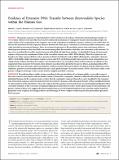| dc.contributor.author | Coyne, Michael J. | en_US |
| dc.contributor.author | Zitomersky, Naamah Levy | en_US |
| dc.contributor.author | McGuire, Abigail Manson | en_US |
| dc.contributor.author | Earl, Ashlee M. | en_US |
| dc.contributor.author | Comstock, Laurie E. | en_US |
| dc.date.accessioned | 2014-07-07T17:03:56Z | |
| dc.date.issued | 2014 | en_US |
| dc.identifier.citation | Coyne, Michael J., Naamah Levy Zitomersky, Abigail Manson McGuire, Ashlee M. Earl, and Laurie E. Comstock. 2014. “Evidence of Extensive DNA Transfer between Bacteroidales Species within the Human Gut.” mBio 5 (3): e01305-14. doi:10.1128/mBio.01305-14. http://dx.doi.org/10.1128/mBio.01305-14. | en |
| dc.identifier.issn | 2150-7511 | en |
| dc.identifier.uri | http://nrs.harvard.edu/urn-3:HUL.InstRepos:12406755 | |
| dc.description.abstract | ABSTRACT The genome sequences of intestinal Bacteroidales strains reveal evidence of extensive horizontal gene transfer. In vitro studies of Bacteroides and other bacteria have addressed mechanisms of conjugative transfer and some phenotypic outcomes of these DNA acquisitions in the recipient, such as the acquisition of antibiotic resistance. However, few studies have addressed the horizontal transfer of genetic elements between bacterial species coresident in natural microbial communities, especially microbial ecosystems of humans. Here, we examine the genomes of Bacteroidales species from two human adults to identify genetic elements that were likely transferred among these Bacteroidales while they were coresident in the intestine. Using seven coresident Bacteroidales species from one individual and eight from another, we identified five large chromosomal regions, each present in a minimum of three of the coresident strains at near 100% DNA identity. These five regions are not found in any other sequenced Bacteroidetes genome at this level of identity and are likely all integrative conjugative elements (ICEs). Such highly similar and unique regions occur in only 0.4% of phylogenetically representative mock communities, providing strong evidence that these five regions were transferred between coresident strains in these subjects. In addition to the requisite proteins necessary for transfer, these elements encode proteins predicted to increase fitness, including orphan DNA methylases that may alter gene expression, fimbriae synthesis proteins that may facilitate attachment and the utilization of new substrates, putative secreted antimicrobial molecules, and a predicted type VI secretion system (T6SS), which may confer a competitive ecological advantage to these strains in their complex microbial ecosystem. | en |
| dc.language.iso | en_US | en |
| dc.publisher | American Society of Microbiology | en |
| dc.relation.isversionof | doi:10.1128/mBio.01305-14 | en |
| dc.relation.hasversion | http://www.ncbi.nlm.nih.gov/pmc/articles/PMC4073490/pdf/ | en |
| dash.license | LAA | en_US |
| dc.title | Evidence of Extensive DNA Transfer between Bacteroidales Species within the Human Gut | en |
| dc.type | Journal Article | en_US |
| dc.description.version | Version of Record | en |
| dc.relation.journal | mBio | en |
| dash.depositing.author | Coyne, Michael J. | en_US |
| dc.date.available | 2014-07-07T17:03:56Z | |
| dc.identifier.doi | 10.1128/mBio.01305-14 | * |
| dash.contributor.affiliated | Comstock, Laurie | |
| dash.contributor.affiliated | Coyne, Michael | |


